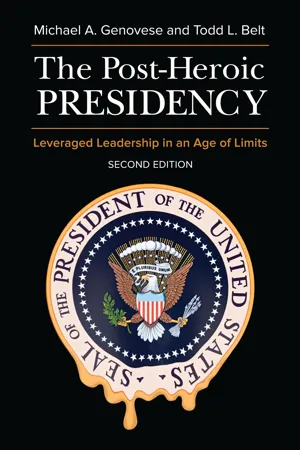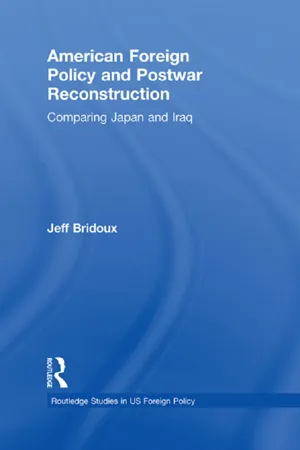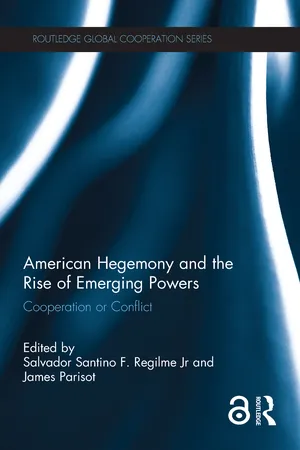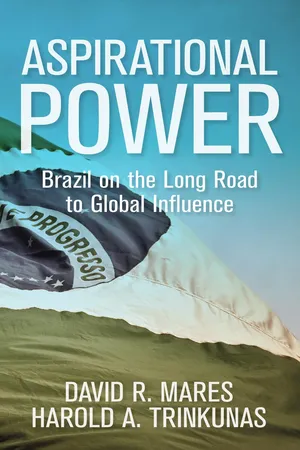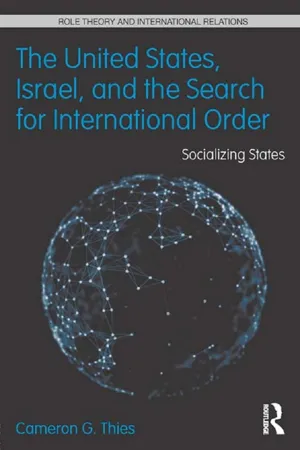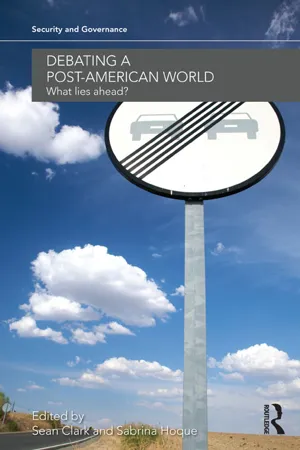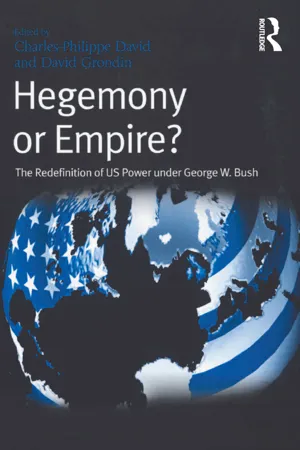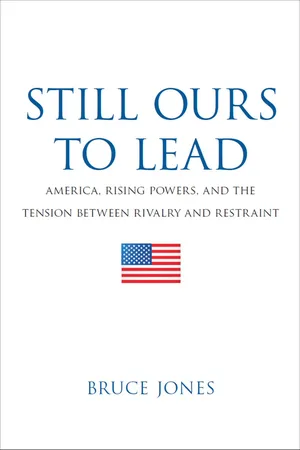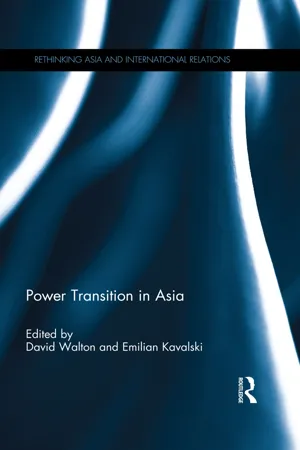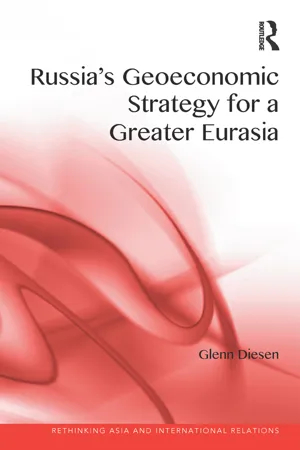History
Emergence of USA as a World Power
The emergence of the USA as a world power refers to the period in the late 19th and early 20th centuries when the United States experienced significant economic, political, and military growth, leading to its status as a dominant global player. This transformation was marked by territorial expansion, industrialization, and involvement in international affairs, culminating in the country's emergence as a leading force in world politics and economics.
Written by Perlego with AI-assistance
Related key terms
Related key terms
1 of 4
Related key terms
1 of 3
10 Key excerpts on "Emergence of USA as a World Power"
- eBook - ePub
The Post-Heroic Presidency
Leveraged Leadership in an Age of Limits
- Michael A. Genovese, Todd L. Belt(Authors)
- 2016(Publication Date)
- Praeger(Publisher)
U.S. POWER IN A CHANGING WORLD
Is the United States a fading power? Will China soon eclipse the United States as the dominant power in the world? The United States—are her best days behind her? Or can bold, creative presidential leadership orchestrate a revival of U.S. power and a renewal of global influence?We do not see U.S. decline as inevitable, nor do we see rivals soon replacing the United States on top of the hill. Of course, there are possible scenarios that could plausibly lead to U.S. decline. We might, for example, shoot ourselves in the foot with wrongheaded self-destructive policies. Our economy could go in the tank, buried in a sea of debt. We could get embroiled militarily somewhere around the globe and deplete our resources and will. An alliance between China and some of its neighbors could dwarf the United States and NATO. None of these scenarios need to occur. Sound leadership, smart policies, and good judgment could be applied to our global challenge, and the United States could remain the global leader for the foreseeable future.What are we to learn about the rise (and fall?) of the American empire from the experiences of other empires in history? It is inevitable that empires collapse? Are there ways to prevent or prolong decline? Can sagging empires revive themselves and reemerge as dominant states? How do leaders lead in times of political and economic decline?Since the 1980s, scholarly attention in political science and international relations has focused on the dramatic changes taking place in the global arena. Likewise, the role and power of the United States in this changing, dynamic environment and the role played by U.S. presidents in this process have been the subject of debate and controversy.In a world of hyperchange, increasing interdependence, and growing interconnectedness, how has U.S. power and hegemony been altered? A heated debate has taken shape in the social sciences over this question. One school of thought, referred to as the “Declinists,” best represented by Yale historian Paul Kennedy argues that the United States is experiencing relative decline due to a variety of factors, most important of which is “imperial overstretch.”2 A competing school, known as the “Revivalists,” best represented by Harvard political scientist Joseph Nye, argues that what we are witnessing is not really decline, but a diffusion of international power and a return to an era of normal hegemony after the artificial impact of the “World War II effect” (whereby the United States was the lone power strengthened by the war) ceases to work in favor of the United States.3 - Jeff Bridoux(Author)
- 2013(Publication Date)
- Routledge(Publisher)
3 ; Robinson 1996; Gilpin 1975; Johnson 2004: 4; Newhouse 2003); even though such a project aiming at American world domination through coercion comes at a domestic and international cost in hard and soft power resources (Brzezinski 2004: 213–15, 2007; Maynes 1998: 39–47). Thus, a broader definition of empire encompassing coercion and consent as expressions of power allows for the unfolding of the explanatory power of the concept of empire in the contemporary era. As several observers noted, the emergence of the debate about the existence and nature of an American empire, despite the rejection of the idea by Americans themselves (Ferguson 2003, 2004: 381), is probably one of the most interesting recent debates about American power. We may not like the discourse of the most virulent neo-imperialists but it is necessary to engage with what they have to say given the influence they exerted on the Bush administration and the amount of ink spilled on the topic (Cox 2004a: 590; Ikenberry 2004a; Bacevich 2003: xiii).The idea of an American empire is currently unavoidable but it is not the concept that we will use in our analysis of postwar reconstruction for two reasons. First, the idea of empire to conceptualise the international order is a static concept that describes a particular mode of relations between states at a specific moment in time and space. The concept of empire only acquires explanatory power when we move from ‘a static description […]. The empire as a territory and as activities dominated economically, politically, and psychologically by a superior power’ to a concept that sees empire as ‘the result of empire as way of life’ defined as ‘the combination of patterns of thought and action that, as it becomes habitual and institutionalized, defines the thrust and character of a culture and society’ (Williams Appleman 2007: 12–13). Chapter Two examines this American imperial way of life by looking at US history and the factors that condition a specific American understanding of power and its use to achieve specific ends, namely to reach and maintain a global supremacy based on ‘the global establishment of capitalism, free-trade, and bourgeois democracy’ (Smith 2003: 455). Thus it is essential to look at the dynamics animating an imperial relationship; to focus on how the power in charge controls outcomes. It is when we observe relations of power between the actors of the international system that we are able to understand how the empire works. As Hunt puts it: the problem with invoking the term empire when referring to US power is that it ‘fails to fully capture the impressive reach of the United States in its post-1945 ascendancy’, a global reach that essentially relied on consensual aspects of power (Hunt 2007).- eBook - ePub
American Hegemony and the Rise of Emerging Powers
Cooperation or Conflict
- Salvador Santino Regilme, James Parisot, Salvador Santino Regilme, James Parisot(Authors)
- 2017(Publication Date)
- Routledge(Publisher)
In other words, it is our contention in this volume that a rethinking of the terms of the debate may be necessary. But this new perspective can only be constructed one piece at a time, by examining the usefulness and limits of theoretical perspectives or academic disciplines one at a time, and foraging through the details of national or regional data individually before linking together the global picture. Differently put, this means continually bringing in new layers of analysis and levels of abstraction to work towards a comprehensive and inclusive world-scale perspective.Main puzzle: cooperation or conflict?The prevalent optimism right after the Cold War in the 1990s motivated policy commentators and scholars to assert that “history has ended” (Fukuyama 1992). The dissolution of the Soviet Union and America’s unparalleled military prowess and extensive diplomatic influence cemented the widespread perception of a US-centric world order especially in the 1990s. In the early 2000s, the 9/11 terror attacks and the “war on terror” demonstrated the limits of American power, and what some scholars call as a signal of “imperial overstretch” (Cox 2003; Pieterse 2004). At the same time, the financial crisis in the late 2007–8 highlighted the fundamental vulnerabilities of the global financial system, particularly centered in Europe and the United States – an outcome that runs contrary to the growing economic clout of emerging powers, particularly China. The increasingly assertive economic diplomacy and strategic military interventions of China in the Asia-Pacific region, as clearly demonstrated in the establishment of artificial islands in the South China Sea maritime area, validates the growing perception that America’s hegemonic leadership is under siege. The election of Donald Trump and emergence of far-right and illiberal political movements within and beyond the West, and the bleak future of European integration, all signal widespread perceptions of uncertainty on the future of Western-led global governance.Viewing those developments, we ask several relevant but all intriguing questions that constitute our puzzle on US hegemony. The first part of the puzzle pertains to the ontological status of the world order as well as the epistemological issues concerning how to know the shifting transformations in international politics (Hurrell 2007; Katzenstein 2012; Narlikar 2013). Is the American-led world order currently in fundamental decline? If the American-led world order is in decline, what are its key manifestations? Is world power diffusing into an era without a hegemon? To what extent are we shifting away from a US-centric world order to a multipolar global system? What sorts of perspectives and empirical evidence are best used to make sense of transformations in the international system? - eBook - ePub
Aspirational Power
Brazil on the Long Road to Global Influence
- David R. Mares, Harold A. Trinkunas(Authors)
- 2016(Publication Date)
- Brookings Institution Press(Publisher)
In contrast, this book focuses on choices made by emerging states, the second-tier great powers. These are the states that have the resources to potentially affect the international system: they have more resources than middle powers, but not enough to rival the system’s great powers. At this stage, emerging powers can either become followers or seek revisions and reforms of the present order’s foundational myths and principles. In this book, we show that Brazil seeks revisions and reforms that would make the four principles undergirding international order more salient and more effective in fully constraining U.S. unilateral behavior. The question for dominant powers such as the United States is whether emerging powers such as Brazil can play a constructive role in supporting the prevailing global order and can become more effective in doing so if their interests can be accommodated or whether these states’ demands and behavior will corrode global governance.EMERGING POWERS: WHO, WHAT, AND WHY?Emerging power status is determined by the accumulation of power that spans military, economic, political, and social arenas. For example, North Korea may have a large army and a few nuclear weapons, but because of its economic weakness, totalitarian governance, and repulsive social policies, it has no ability to influence anything beyond its own security; the North Korean government knows that and does not seek to become a player in discussions about the future of the international order. We argue that as states develop their power across domains relevant to the governance of the prevailing international order, they will reach a point where they will seek to “emerge” into global leadership positions. Emerging powers are identified as such because they are on a path that will move them from the middle ranks to great power ranks. No one (except their neighbors) is particularly interested in the small power that rises to a middle power position, but those countries that rise to the top rungs are watched closely. - eBook - ePub
The United States, Israel, and the Search for International Order
Socializing States
- Cameron G. Thies(Author)
- 2013(Publication Date)
- Routledge(Publisher)
Chapter 2 . Bailey (1969: 30) decries the pitfalls of periodization in the history of US foreign policy. For example, during the time he was writing, Bailey says that all schoolchildren were taught to accept uncritically that the United States was a great power after 1898. Bailey takes issue with this periodization but is quick to offer one of his own. Bailey (1969: 31) suggests that the United States was a “world power” at birth on July 2, 1776. A world power is “a nation with sufficient power in being, or capable of being mobilized, to effect world politics positively over a period of time.” Bailey (1969: 43) also argues that the United States was a European power at birth. But Bailey (1969: 49) does not consider the United States a great power until the end of the Civil War.Charles and Mary Beard (1921) also assert that the United States was a world power from the time of Edmund Burke's March, 1775, speech on conciliation. However, Bailey's and the Beards' views on the subject are not the standard interpretation. Almost every historian has a different way of classifying periods of diplomatic history according to the perceived status or capabilities of the United States. Bemis (1962a: 3) offers a categorization scheme that is not even mutually exclusive.7 For example, he considers the period 1776–1823 the era of revolution and emancipation, and the period from 1815–1915 as the era of isolation and security. Varg (1990) offers six such periods of foreign policy transition in US history.Klingberg (1983, 1996) identifies five periods in US foreign policy: 1775/76–1824 (the revolutionary period), 1824–1871 (rounding out the nation), 1871–1917/18 (becoming an industrial power), 1917/18–1966/67 (world crisis for freedom), and 1966/67–present (the search for world peace). These periods are further divided into eight international mood phases reflecting introversion or extroversion in US foreign policy. These periods are demarcated by a mixture of domestic-level events, such as the unrest over Vietnam during the Johnson Administration, and internationallevel events, such as World War I. The problem with this periodization, as well as those employed by many historians, is that the demarcations are caused by dissimilar events. - eBook - ePub
Debating a Post-American World
What Lies Ahead?
- Sean Clark, Sabrina Hoque(Authors)
- 2013(Publication Date)
- Routledge(Publisher)
11Zakaria paints a rosy picture of future US economic power. One doubts he would have done so had he written after the Great Recession. Looking ahead, the United States faces serious economic problems. Its fiscal situation is especially bleak. Because of soaring budget deficits and the entitlements overhang, the United States’ federal government debt-to-GDP ratio could approach 100 percent by 2020 (the same year that China may surpass the United States as the world's number one economy) – a level that, by any measure, would be unsustainable.12 Moreover, because of its budget and balance of payments deficits, the United States is dependent on loans from foreign creditors – especially China. To avoid runaway inflation, keep foreign loans flowing, and prevent an assault of the dollar's status as the international economy's primary reserve currency, the United States will be looking at difficult trade-offs among higher taxes, higher interest rates, and draconian cuts in federal spending.13 To regain fiscal solvency, the United States almost certainly will find itself compelled to make dramatic cuts in defense spending and to engage in a process of strategic retrenchment.Looking forward: toward the real post-American world
Following World War II, the United States wielded its enormous military, political, economic, and soft power resources to build a Pax Americana based on a web of security alliances, international institutions, and an open international economy. The end of the Cold War strengthened the Pax Americana, and enabled the United States to extend its geographic scope. Under the Pax Americana the United States provided the key public goods that underwrote the international order. In the realm of security, the United States acted as the regional stabilizer in Europe, East Asia, and the Persian Gulf, and also guarded the global commons. Economically, the United States played the pivotal role in promoting growth and openness in the international economy by acting as both the market and lender of last resort, and by providing the global system's reserve currency. The days of the Pax Americana are numbered, however. US dominance will be challenged by the rising great powers at the same time that fiscal and economic constraints will force the United States to downsize its global role. - eBook - ePub
Hegemony or Empire?
The Redefinition of US Power under George W. Bush
- David Grondin, Charles-Philippe David(Authors)
- 2016(Publication Date)
- Routledge(Publisher)
Chapter 1Theory Wars of Choice: Hidden Casualties in the ‘Debate’ Between Hegemony and Empire
Robert VitalisFor analyses of world politics since the George W. Bush administration’s overthrow of the Taliban in Afghanistan and of Saddam Hussein in Iraq, the main hypothesis to be tested and if possible rejected is that the moment is one in which an old world order is dying and a new world order is being born. Thus it is easy to imagine a few of the key debates in advance. Some will argue for the signal importance of 9/11. Others will argue that the changes were obvious or nascent or incipient before the attacks on New York and Washington. Still others will argue that none of what we proclaim to be new is in fact new save at the margins, and certainly not in how power is being wielded and for what objectives. And though it won’t be a main question among students of international relations, you can also imagine the argument turned on its head. We are witnessing a radical transformation in the American political economy, what Walter Dean Burnham calls with reference to earlier moments, the 1890s and 1930s, a ‘critical realignment’.1 Answering questions such as these correctly or even asking the right questions hinges on an adequate understanding of the institutions that make up the contemporary world system. The problem is that many journalists, scholars and activists have gotten it more wrong than right in lining up against the new, so-called American ‘wars of choice’. Consider the confusion that emerges in discussions of something called empire and something else called hegemony. There are at least two kinds of analytical errors in current writings. One is the routine treatment of the two terms as synonyms, ignoring or ignorant of the work, starting with Immanuel Wallerstein, that shows how these two modes of international domination are different from one another.2 - eBook - ePub
Still Ours to Lead
America, Rising Powers, and the Tension between Rivalry and Restraint
- Bruce D. Jones(Author)
- 2014(Publication Date)
- Brookings Institution Press(Publisher)
PART IA GREATLY EXAGGERATED DECLINE
The Fall and Rise of Major PowersPassage contains an image
CHAPTER ONE
AMERICA'S ENDURING POWER
I n May 2006 the Financial Times published a survey of the most influential commentators in the world. Topping the list for the United States was Charles Krauthammer.1 Krauthammer was cited for two articles he had written in the previous half decade: a manifesto for an ambitious program of American power projection titled “Democratic Realism” and an essay in Foreign Affairs magazine that defined the post–cold war moment as one of “unipolarity,” or U.S. dominance.Krauthammer was far from alone in reveling in a sense of American dominance. The launch of the wars in Afghanistan and Iraq and the start of the “global war on terror” occasioned a heady sense of the global reach of unfettered American power. A flurry of books and articles extolled the extent of American dominance and the merits of the American “empire.” Issues for debate were whether the American empire was grander than that of Rome at its height, how long it would last, and whether America could sustain an imperial role while maintaining a liberal political character. Not questioned was the notion that America stood astride the globe, alone.There was irony in the timing of the triumphalism. Just as Krauthammer and others were celebrating American dominance, a deep shift in the economic grounding of American power was beginning. The story is encapsulated by two numbers: 20 percent and 75 percent. Twenty percent is the proportion of the United States economy, measured by GDP, that the combined economies of China, India, and Brazil equaled in the year 2000. By 2010 that proportion was just over 75 percent. What a difference a decade makes.The narrative has thus moved from debates about unipolarity and empire to ones about multipolarity and decline. Ever since the onset of the global financial crisis, it has become commonplace to refer to the fact that the world is now multipolar. Long, and fortunately, gone are the bipolar days of the cold war, when the two roughly equal superpowers stood eyeball-to-eyeball, backed by their respective blocs of allies or client states. But gone too is the brief moment of untrammeled U.S. power and with it, it is argued, U.S. leadership of the international system.2 - eBook - ePub
- David Walton, Emilian Kavalski(Authors)
- 2016(Publication Date)
- Routledge(Publisher)
Amid all this speculation, academics finally began to take note of the fact that something quite extraordinary appeared to be happening. This had certainly not been predicted. Indeed, so dazzled were most analysts by the enormous power being wielded by the USA during the 1990s that it had become very difficult to contemplate the idea that the West might be under challenge – let alone think that a still relatively backward China would one day become a serious threat. Indeed, very many scholars (though not all) took the not illogical view that having only just emerged from decades of poverty and self-imposed isolation, China was bound to remain an incomplete power. However, this soon changed. The sheer speed of China’s economic development and China’s growing role in its own region (not to mention in Africa and Latin America) looked like it was enormously significant. Whether this transformation would inevitably lead – as some realists predicted it might – to increased conflict with the West remained an open and much debated question. But one thing seemed palpably obvious. As a result of one of the most amazing economic transformations in centuries, China (and the other rising powers in the East) were forcing academics to think for the first time in a long time – and after many years of American dominance in a unipolar world – about the possibility of a major change in the balance of world power (Cox, 2011).In this chapter I critically consider the power shift thesis. In the first section I assess how far the USA has, in fact, declined economically, as many now seem to think it has. In the second section I look at two measures of power – hard and soft – and suggest that the West still retains a great deal of both. In the third section I look at other indicators of western power. Finally, I look at Asia and the idea of an Asian century. Here I suggest that we should be wary of making too many claims on behalf of this enormously diverse region. Its very many economic achievements are real and important, but this should not lead us into making unsustainable predictions about its future. It is still too soon to talk of a new Asian century.The USA: a declining hegemon?
A large part of the case in favour of the notion that a ‘power shift’ is underway rests on the assumption that the leading western player – the United States of America – faces an irresistible economic decline that will, if it continues, either allow others to take advantage of its weakness or reduce its ability to lead. Certainly, many ordinary Americans, and those who comment on the USA today, believe this to be the case. Of course, the story can be, and has been, told in very different ways. For some, the process is likely to be slow and can be managed rather easily, even ‘politely’ (Quinn, 2011). For others, it is bound to have enormous consequences, not only for the conduct of US foreign policy, but also for the world at large. Certainly, if one accepts the theory of hegemonic stability (and believes that the hegemon is now in decline) then the future of the world looks very problematic indeed (for a more positive spin, see Buzan, 2011). Either way, with the US share of world trade falling, its debt increasing, its economy in slowdown and its dependency on foreign purchasers of its debt on the rise, along with China rising economically, it looks to many analysts as if the USA will either ‘need to retrench’ (Layne, 2012, p. 22) or, more problematically, be forced to pass the baton to other more capable powers (Sachs, 2009). - Glenn Diesen(Author)
- 2017(Publication Date)
- Routledge(Publisher)
2 The rise, decline and potential revival of US geoeconomic powerIntroduction
The rise, decline and potential revival of US geoeconomic power are surveyed as indicators for both opportunities and challenges in Russia’s external environment. The US is the principal balancer of Russia and has strategic interests diametrically opposed to economic connectivity between major Eurasian land powers such as Russia, China, Germany and Iran. The dominant military power of the US has ensured control over key transportation corridors and strategic resources, while monetary and financial clout produces control over key chokepoints in the global economy. The relative decline of US geoeconomic power produces systemic incentives for rivals to challenge the status quo, yet the US still has opportunities to resuscitate some of its former geoeconomic authority.This chapter will first explore the rise and decline of US geoeconomic power. The US has since the late 1800s performed remarkably as a geoeconomic maritime power by controlling strategic sea routes, thrived with trade and pursued inexpensive offshore balancing in Eurasia. The Second World War created systemic incentives for the US to expand its geoeconomic reach globally. Albeit, the war also produced a severely skewed balance of power in Eurasia and economic statecraft had limited impact on the Soviet Union as a communist state largely disconnected from international markets. America’s extensive and increasing militarisation to balance the Soviet Union led to its geoeconomic power regressing towards traditional geopolitics. The US did not reform and return to geoeconomics after the Cold War since military power was conceived as the main instrument to sustain the unipolar moment.The US has ample potential to revive its geoeconomic power, which could present both challenges and opportunities to Russia. The ‘shale revolution’ is set to make the US an energy exporter determined to undermine Russia’s position in Europe, while the TPP/TTIP trade agreements that have been berated and will probably be cancelled by the Trump administration would have been powerful economic tools to marginalise both China and Russia. The US is under mounting pressure to abandon the unipolar moment as it incentivises collective balancing of the US by major powers such as China, Russia and Iran. Accommodating Russia or China to a greater extent could be instrumental in restoring some division and an internal balance of power in Eurasia. Realist theory would expect that the US would increasingly abandon containment of Russia since China is the principal geoeconomic rival. However, the ability to contain Russia is greater, especially following the Ukraine crisis.
Index pages curate the most relevant extracts from our library of academic textbooks. They’ve been created using an in-house natural language model (NLM), each adding context and meaning to key research topics.
Explore more topic indexes
Explore more topic indexes
1 of 6
Explore more topic indexes
1 of 4
